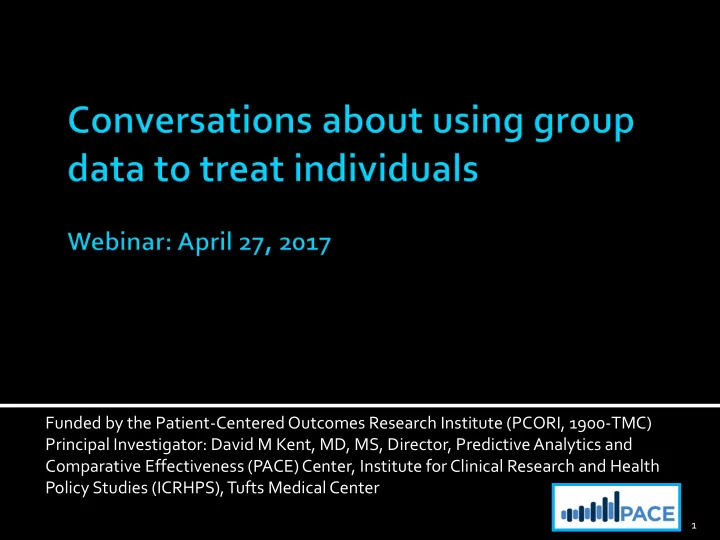

Funded by the Patient-Centered Outcomes Research Institute (PCORI, 1900-TMC) Principal Investigator: David M Kent, MD, MS, Director, Predictive Analytics and Comparative Effectiveness (PACE) Center, Institute for Clinical Research and Health Policy Studies (ICRHPS), Tufts Medical Center 1
Information and comments you share will Be used for research only Be treated confidentially Not be attributed you or your organization Please protect others in the discussion by not repeating anything you hear in a way that is attributable to a person or organization Keep in mind that PACE and Tufts Medical Center cannot guarantee that everything you say will be kept confidential by all of the participants 2
We don't want to miss any of your comments. The recordings will be used to create de- identified transcripts. After transcripts have been created, the recordings will be destroyed. A summary article will be published. You will see the report before it is published. Only aggregate results will be reported. No information will be attributed to individuals. Funder and public will not see who made comments. 3
Take care of yourself & ask for what you need Ask questions (some medical terms may be unfamiliar) Step up, step back (draw out others’ ideas ) Agree to disagree Acknowledge everyone’s experience is different “ One mic ” (please mute phone when not speaking) Others? 4
David Tom Tufts Medical Center RAND Corporation 5
What is your first name and where are you from? Do you belong to any patient or health care community? Tell us one interesting thing about yourself 6
Welcome and Introductions – 10 mins Introduction to Evidence-based Medicine – 30 mins How to apply clinical trial results and subgroup analyses to individual patients – 30 mins Additional discussion – 15 mins Final comments – 5 mins 7
Welcome and Introductions – 10 mins Introduction to Evidence-based Medicine – 30 mins How to apply clinical trial results and subgroup analyses to individual patients – 30 mins Additional discussion – 15 mins Final comments – 5 mins 8
the use of current best evidence in decisions about the care of patients. - Sackett JAMA 1996 Traditional medicine: Evidence-based medicine: based on experience based on data 9
What is misleading about Bill’s statement? “Michael and I combined for 57 points” - Bill Wennington, 1995 10
Harm Benefit 11
HARM ACTUAL OUTCOME COUNTER FACTUAL OUTCOME BENEFIT BENEFIT HARM BENEFIT Harm Benefit 12
Without Treatment With Treatment 0 = alive 0 1 1 = dead 0 0 0 0 1 0 1 0 1 1 1 1 1 1 0 1 1 1 1 1 1 0 0 0 1 1 BENEFIT 0 0 0 0 1 1 0 0 0 0 1 0 Proportion 11/20 9/20 Dead (55%) (45%) 13
Welcome and Introductions – 10 mins Introduction to Evidence-based Medicine – 30 mins How to apply clinical trial results and subgroup analyses to individual patients – 30 mins Additional discussion – 15 mins Final comments – 5 mins 14
Jane had a small stroke 1 month ago 45 year old female No other major problems like diabetes or high blood pressure Jane and her doctor are deciding on the best treatment to prevent a future stroke Research says: on average, treatment A is better than treatment B 15
Am I similar to Should I start the “average” person from the Treatment A? research study? Which treatment works best in patients like me? 16
Is the answer clear to you? What would you recommend Jane do? 17
We already know, research says: on average, treatment A is better than treatment B Subgroup analyses reveal that: Jane is -45 years old Treatment B is better than -Female treatment A for younger patients -Had a small (less than age 50) stroke 1 Treatment A works better than month ago Which treatment B for women -Has no other treatment Treatment A works better than major problems works best in treatment B for patients with normal blood pressure patients like Treatments A and B work about the me? same for non-diabetics 18
Did subgroup information help you make a decision, or did it make your decision more difficult? Did subgroup information change your mind? What do you recommend Jane do? 19
Problems with overall results Problems with subgroup analyses 20
Evidence comes from groups; decisions are made by and for individuals Overall average results do not necessarily apply to all patients 21
Traditional subgroup analysis compares groups that differ only on a single factor Patients have many attributes simultaneously Not patient-centered, no person is one-factor Testing many factors will result in some false- positive associations (multiplicity) Does not represent the full spectrum of patient heterogeneity 22
Welcome and Introductions – 10 mins Introduction to Evidence-based Medicine – 30 mins How to apply clinical trial results and subgroup analyses to individual patients – 30 mins Additional discussion – 15 mins Final comments – 5 mins 23
What information can you recall needing to make decisions about your care? If you asked a provider for more information: How did you ask your question(s)? Do you recall the answer(s) you got? How would you phrase these questions now? Do you have any new questions about your care? 24
Welcome and Introductions – 10 mins Introduction to Evidence-based Medicine – 30 mins How to apply clinical trial results and subgroup analyses to individual patients – 30 mins Additional discussion – 15 mins Final comments – 5 mins 25
26
27
You will receive a follow-up email. To compensate for your time and contributions, you will receive a $50 Mastercard gift card by US postal mail. An article will be written based on summary results from the webinar series. You will be sent a copy before publication. Please contact us with questions or suggestions at jlutz@tuftsmedicalcenter.org. 28
Recommend
More recommend